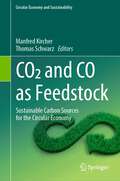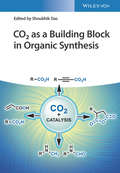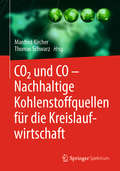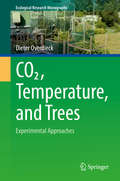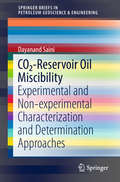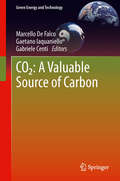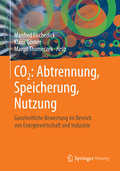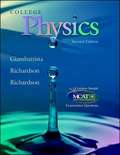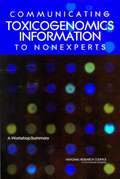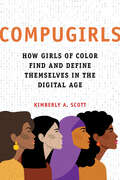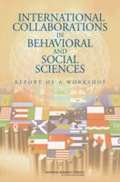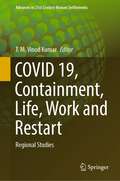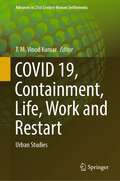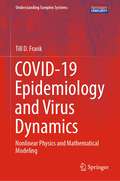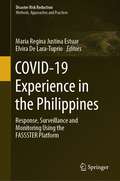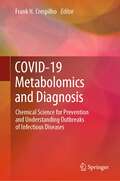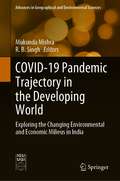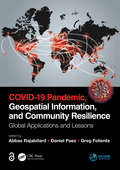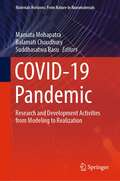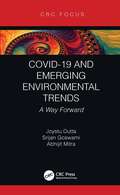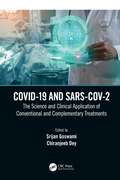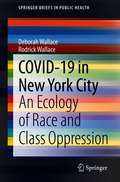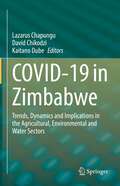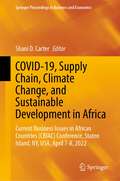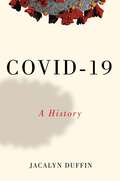- Table View
- List View
CO2 and CO as Feedstock: Sustainable Carbon Sources for the Circular Economy (Circular Economy and Sustainability)
by Thomas Schwarz Manfred KircherClimate protection and raw material change require new, sustainable carbon sources for the chemical and fuel industries. In fact, processes that recycle carbon-containing emission and gas streams industrially are reaching industrial practice. They will make an important contribution to reducing carbon emissions and moving towards a true carbon circular economy. This book describes the basics of chemical and biotechnological processes for converting CO and CO2 into chemicals and fuels. Furthermore, it addresses potentials for the manufacturing economy, industrial sites and regions and answers the following questions. Which emission and gas streams offer feedstock potential? What processes are already implemented, being tested and under development?What products can be made from gaseous carbon sources?How can carbon emitting and consuming industries be linked into new value chains?What is the regulatory framework?What does the ecological footprint look like?How do the new processes contribute to the regional economy and thus to social acceptance among consumers and among decision-makers in companies and politics?Providing companies with sustainable carbon sources is a central question of the circular economy, which must be answered with technical processes, new cross-sector value chains, adapted infrastructure and further developed framework conditions. This concerns scientists and decision-makers in companies alike. In this book, they as well as interested laymen will find a comprehensive overview of the state of the art in both, technology and research, and of the overriding issues involved in establishing CO2 and CO as feedstocks.
CO2 as a Building Block in Organic Synthesis
by Shoubhik DasA guide to the fascinating application of CO2 as a building block in organic synthesis This important book explores modern organic synthesis’ use of the cheap, non-toxic and abundant chemical CO2 as an attractive C1 building block. With contributions from an international panel of experts, CO2 as Building Block in Organic Synthesis offers a review of the most important reactions which use CO2 as a building block in organic synthesis. The contributors examine a wide-range of CO2 reactions including methylation reactions, CH bond functionalization, carboxylation, cyclic carbonate synthesis, multicomponent reactions, and many more. The book reviews the most recent developments in the field and also: Presents the most important reactions like CH-bond functionalization, carboxylation, carbonate synthesis and many more Contains contributions from an international panel of experts Offers a comprehensive resource for academics and professionals in the field Written for organic chemists, chemists working with or on organometallics, catalytic chemists, pharmaceutical chemists, and chemists in industry, CO2 as Building Block in Organic Synthesis contains an analysis of the most important reactions which use CO2 as an effective building block in organic synthesis.
CO2 und CO – Nachhaltige Kohlenstoffquellen für die Kreislaufwirtschaft
by Thomas Schwarz Manfred KircherKlimaschutz und Rohstoffwandel erfordern für die Chemie- und Treibstoffindustrie neue, nachhaltige Kohlenstoffquellen. Tatsächlich erreichen Verfahren, die kohlenstoffhaltige Emissions- und Gasströme industriell verwerten, die industrielle Praxis. Sie werden auch in Europa einen wichtigen Beitrag zur Senkung der Kohlenstoff-Emission und für den Einstieg in eine echte Kohlenstoff-Kreislaufwirtschaft leisten.Dieses Buch beschreibt die Grundlagen chemischer und biotechnologischer Verfahren zur Umsetzung von CO und CO2 zu Chemikalien und Treibstoffen und geht auf das Potential für die produzierende Wirtschaft, Industriestandorte und Regionen ein:Welche Emissions- und Gasströme bieten Rohstoffpotential? Welche Verfahren werden bereits implementiert, werden geprüft und sind in Entwicklung?Welche Produkte können aus gasförmigen Kohlenstoffquellen hergestellt werden?Wie können Kohlenstoff abgebende und verbrauchende Industrien zu neuen Wertschöpfungsketten verknüpft werden?Wie sehen die regulatorischen Rahmenbedingungen aus?Wie sieht der ökologische Fußabdruck aus?Wie tragen die neuen Verfahren zur regionalen Wirtschaft bei und unterstützen damit die gesellschaftliche Akzeptanz?
CO2, Temperature, and Trees: Experimental Approaches (Ecological Research Monographs)
by Dieter OverdieckThis comprehensive book discusses the ecophysiological features of trees affected by the two most prominent factors of climate change: atmospheric CO2 concentration and temperature. It starts with the introduction of experimental methods at the leaf, branch, the whole-tree, and tree group scales, and in the following chapters elaborates on specific topics including photosynthesis of leaves, respiration of plant organs, water use efficiency, the production of and/or distribution patterns of carbohydrates, secondary metabolites, and nutrients, anatomy of cells and tissues, height and stem-diameter growth, biomass accumulation, leaf phenology and longevity, and model ecosystems (soil-litter-plant enclosures). The current knowledge is neatly summarized, and the author presents valuable data derived from his 30 years of experimental research, some of which is published here for the first time. Using numerous examples the book answers the fundamental questions such as: What are the interactions of elevated CO2 concentration and temperature on tree growth and matter partitioning? How do different tree groups react? Are there any effects on organisms living together with trees? What kinds of models can be used to interpret the results from experiments on trees? This volume is highly recommended for researchers, postdocs, and graduate students in the relevant fields. It is also a valuable resource for undergraduate students, decision-makers in the fields of forest management and environmental protection, and any other scientists who are interested in the effect of global change on ecosystems.
CO2-Reservoir Oil Miscibility: Experimental and Non-experimental Characterization and Determination Approaches (SpringerBriefs in Petroleum Geoscience & Engineering)
by Dayanand SainiThis SpringerBrief critically examines the latest experimental and non-experimental approaches used for the fast and reliable characterization and determination of CO2-reservoir oil miscibility in terms of the minimum miscibility pressure (MMP). This book serves as a one-stop source for developing an enhanced understanding of these available methods, and specifically documents, analyses, and evaluates their suitability and robustness for depicting and characterizing the phenomenon of CO2-reservoir oil miscibility in a fast and cost-effective manner. Such information can greatly assist a project team in selecting an appropriate MMP determination method as per the project’s need at a given project’s stage, be that screening, design, or implementation. CO2-Reservoir Oil Miscibility: Experiential and Non-Experimental Characterization and Determination Approaches will be of interest to petroleum science and engineering professionals, researchers, and undergraduate and graduate students engaged in CO2 enhanced oil recovery (EOR) and/or simultaneous CO2-EOR and storage projects and related research. It may also be of interest to engineering and management professionals within the petroleum industry who have responsibility for implementing CO2-EOR projects.
CO2: A Valuable Source Of Carbon (Green Energy and Technology)
by Gaetano Iaquaniello Marcello De Falco Gabriele CentiAs the annual production of carbon Dioxide (CO2) reaches 30 billion tones, the growing issue of the greenhouse effect has triggered the development of technologies for CO2 sequestration, storage and use as a reactant. Collecting together the reports of the Congress at University of Rome (Campus Bio-medico) held 16th April 2012, CO2: A Valuable Source of Carbon presents and discusses promising technologies for the industrial exploitation of CO2. Divided into two parts, the current technology is evaluated and summarized before European and national projects are presented. The focus on CO2 recovery, particularly in value-added production, proposes applicable methods to develop sustainable practices and even to mitigate greenhouse gas emission from large-scale fossil fuels usage. Including current data and real-world examples, CO2: A valuable source of carbon provides students, engineers, researchers and industry professional with up-to-date material and potential areas for development and research.
CO2: Ganzheitliche Bewertung im Bereich von Energiewirtschaft und Industrie
by Manfred Fischedick Klaus Görner Margit ThomeczekAusgehend von den naturwissenschaftlichen und technischen Grundlagen werden in dem Band Technologien zur Abscheidung, Speicherung und Nutzung von klimasch#65533;dlichem CO2 vorgestellt. Der Stand der Technik wird dargelegt, die Energiebilanzen verschiedener Techniken verglichen, rechtliche, wirtschaftliche und gesellschaftspolitische Aspekte beschrieben und dar#65533;ber hinaus die Standpunkte der verschiedenen Interessengruppen vorgestellt. Um sachlich informieren zu k#65533;nnen, legen die Autoren die Kriterien f#65533;r die Bewertung der einzelnen Sichtweisen offen.
COLLEGE Physics: With An Integrated Approach To Forces And Kinematics
by Robert C. Richardson Alan Giambattista Betty McCarthy RichardsonNIMAC-sourced textbook
COMMUNICATING TOXICOGENOMICS INFORMATION TO NONEXPERTS: A Workshop Summary
by National Research Council of the National AcademiesThe National Academies Press (NAP)--publisher for the National Academies--publishes more than 200 books a year offering the most authoritative views, definitive information, and groundbreaking recommendations on a wide range of topics in science, engineering, and health. Our books are unique in that they are authored by the nation's leading experts in every scientific field.
COMPUGIRLS: How Girls of Color Find and Define Themselves in the Digital Age (Dissident Feminisms)
by Kimberly A. ScottWhat does is it mean for girls of color to become techno-social change agents--individuals who fuse technological savvy with a deep understanding of society in order to analyze and confront inequality? Kimberly A. Scott explores this question and others as she details the National Science Foundation-funded enrichment project COMPUGIRLS. This groundbreaking initiative teaches tech skills to adolescent girls of color but, as importantly, offers a setting that emphasizes empowerment, community advancement, and self-discovery. Scott draws on her experience as an architect of COMPUGIRLS to detail the difficulties of translating participants' lives into a digital context while tracing how the program evolved. The dramatic stories of the participants show them blending newly developed technical and communication skills in ways designed to spark effective action and bring about important change. A compelling merger of theory and storytelling, COMPUGIRLS provides a much-needed roadmap for understanding how girls of color can find and define their selves in today's digital age.
CONDENSED-MATTER AND MATERIALS PHYSICS: The Science of the World Around Us
by National Research Council of the National AcademiesThe development of transistors, the integrated circuit, liquid-crystal displays, and even DVD players can be traced back to fundamental research pioneered in the field of condensed-matter and materials physics (CMPP). The United States has been a leader in the field, but that status is now in jeopardy. Condensed-Matter and Materials Physics, part of the Physics 2010 decadal survey project, assesses the present state of the field in the United States, examines possible directions for the 21st century, offers a set of scientific challenges for American researchers to tackle, and makes recommendations for effective spending of federal funds. This book maintains that the field of CMPP is certain to be principle to both scientific and economic advances over the next decade and the lack of an achievable plan would leave the United States behind. This book's discussion of the intellectual and technological challenges of the coming decade centers around six grand challenges concerning energy demand, the physics of life, information technology, nanotechnology, complex phenomena, and behavior far from equilibrium. Policy makers, university administrators, industry research and development executives dependent upon developments in CMPP, and scientists working in the field will find this book of interest.
COVID 19, Containment, Life, Work and Restart: Regional Studies (Advances in 21st Century Human Settlements)
by T. M. Vinod KumarThis book is about containment, life, work, and restart regions affected by COVID 19, using selected empirical case studies. This book presents the spread of coronavirus spatially and temporally, analyses containment strategies and includes recommended strategies. Further, it analyses how life and work get transformed during the lockdown, and gradual opening up, and presents the future of work and life in cities impacted by COVID-19. This book discusses the concept of smart life and works in cities post-COVID-19 such that they do not reduce the quality of work and life and cannot create adverse economic and living consequences called the restart of a city after COVID-19.Selected Regions of special interest are studied. Special interest is because Kerala and Maharashtra got the worst affected in India by COVID 19 pandemic and the book focus on that.
COVID 19, Containment, Life, Work and Restart: Urban Studies (Advances in 21st Century Human Settlements)
by T. M. Vinod KumarThis book is about containment, life, work, and restart cities affected by COVID 19, using selected empirical case studies. This book presents the spread of coronavirus spatially and temporally, analyses containment strategies and includes recommended strategies. Further, it analyses how life and work get transformed during the lockdown, and gradual opening up, and presents the future of work and life in cities impacted by COVID-19. This book discusses the concept of smart life and works in cities post-COVID-19 such that they do not reduce the quality of work and life and cannot create adverse economic and living consequences called the restart of a city after COVID-19.Selected Cities of special interest are studied. Special interest is because Kerala and Maharashtra got the worst affected in India by COVID 19 pandemic and the book focus on that.
COVID-19 Epidemiology and Virus Dynamics: Nonlinear Physics and Mathematical Modeling (Understanding Complex Systems)
by Till D. FrankThis book addresses the COVID-19 pandemic from a quantitative perspective based on mathematical models and methods largely used in nonlinear physics. It aims to study COVID-19 epidemics in countries and SARS-CoV-2 infections in individuals from the nonlinear physics perspective and to model explicitly COVID-19 data observed in countries and virus load data observed in COVID-19 patients. The first part of this book provides a short technical introduction into amplitude spaces given by eigenvalues, eigenvectors, and amplitudes.In the second part of the book, mathematical models of epidemiology are introduced such as the SIR and SEIR models and applied to describe COVID-19 epidemics in various countries around the world. In the third part of the book, virus dynamics models are considered and applied to infections in COVID-19 patients. This book is written for researchers, modellers, and graduate students in physics and medicine, epidemiology and virology, biology, applied mathematics, and computer sciences. This book identifies the relevant mechanisms behind past COVID-19 outbreaks and in doing so can help efforts to stop future COVID-19 outbreaks and other epidemic outbreaks. Likewise, this book points out the physics underlying SARS-CoV-2 infections in patients and in doing so supports a physics perspective to address human immune reactions to SARS-CoV-2 infections and similar virus infections.
COVID-19 Experience in the Philippines: Response, Surveillance and Monitoring Using the FASSSTER Platform (Disaster Risk Reduction)
by Maria Regina Justina Estuar Elvira De Lara-TuprioThis book provides an overview of the extensive work that has been done on the design and implementation of the COVID-19 Philippines Local Government Unit Monitoring Platform, more commonly known as Feasibility Analysis of Syndromic Surveillance Using Spatio-Temporal Epidemiological Modeler for Early Detection of Diseases (FASSSTER). The project began in 2016 as a pilot study in developing a multidimensional approach in disease modeling requiring the development of an interoperable platform to accommodate input of data from various sources including electronic medical records, various disease surveillance systems, social media, online news, and weather data. In 2020, the FASSSTER platform was reconfigured for use in the COVID-19 pandemic. Using lessons learned from the previous design and implementation of the platform toward its full adoption by the Department of Health of the Philippines, this book narrates the story of FASSSTER in two main parts.Part I provides a historical perspective of the FASSSTER platform as a modeling and disease surveillance system for dengue, measles and typhoid, followed by the origins of the FASSSTER framework and how it was reconfigured for the management of COVID-19 information for the Philippines. Part I also explains the different technologies and system components of FASSSTER that paved the way to the operationalization of the FASSSTER model and allowed for seamless rendering of projections and analytics. Part II describes the FASSSTER analytics and models including the Susceptible-Exposed-Infected-Recovered (SEIR) model, the model for time-varying reproduction number, spatiotemporal models and contact tracing models, which became the basis for the imposition of restrictions in mobility translated into localized lockdowns.
COVID-19 Metabolomics and Diagnosis: Chemical Science for Prevention and Understanding Outbreaks of Infectious Diseases
by Frank N. CrespilhoThis book focus on COVID-19 topics, with emphasis on metabolomics and diagnosis. The chapters cover the chemical science for prevention and understanding outbreaks of infectious diseases. This book compiles the most widespread methodologies of application of quality statistical tools added to the evaluation of diagnostic tests for detection of SARS-CoV-2, metabolic behavior of COVID infection severity, and trends in rapid test for COVID-19.
COVID-19 Pandemic Trajectory in the Developing World: Exploring the Changing Environmental and Economic Milieus in India (Advances in Geographical and Environmental Sciences)
by R. B. Singh Mukunda MishraWe are witnessing an unprecedented global outbreak of COVID-19, which has been devastating in its consequences. Beyond the acute health hazard, the pandemic has carried with it other threats for mankind associated with the human economy, society, culture, psychology and politics. Amidst these multifarious dimensions of the pandemic, it is high time for global solidarity to save humankind.Human society, its ambient environment, the process of socio-economic development, and politics and power – all are drivers to establish the world order. All these parameters are intimately and integrally related. The interconnections of these three driving forces have a significant bearing on life, space and time. In parallel, the interrelationship between all these drivers is dynamic, and they are changed drastically with time and space. The statistics serve to align the thought, based on which social scientists need to understand the prevailing equation to project the unforeseen future. The trajectory of the future world helps in planning and policymaking with a scientific direction.The practitioners of all academic disciplines under the umbrella of the social sciences need a common platform to exchange ideas that may be effective in the sustainable management of the crisis and the way forward after it is mitigated. This book provides multidisciplinary contributions for expressing the solidarity of academic knowledge to fight against this global challenge. It is crucial that there should be an on-going discussion and exchange of ideas, not only from the perspective of the current times but keeping in view the preparedness for unforeseen post-COVID crises as well.
COVID-19 Pandemic, Geospatial Information, and Community Resilience: Global Applications and Lessons
by Abbas RajabifardGeospatial information plays an important role in managing location dependent pandemic situations across different communities and domains. Geospatial information and technologies are particularly critical to strengthening urban and rural resilience, where economic, agricultural, and various social sectors all intersect. Examining the United Nations' SDGs from a geospatial lens will ensure that the challenges are addressed for all populations in different locations. This book, with worldwide contributions focused on COVID-19 pandemic, provides interdisciplinary analysis and multi-sectoral expertise on the use of geospatial information and location intelligence to support community resilience and authorities to manage pandemics.
COVID-19 Pandemic: Research and Development Activities from Modeling to Realization (Materials Horizons: From Nature to Nanomaterials)
by Balamati Choudhury Mamata Mohapatra Suddhasatwa BasuThis book provides a comprehensive overview of recent novel coronavirus (SARS-CoV-2) infection and discusses developments in the field of nanoparticle/inorganic/organic materials development for antiviral application, therapeutic applications, PPE kit formulations and inclusion of simulated data. The contents focus on measures to keep the infections in check, materials aspects for detection and monitoring, AI modeling for prediction of spread of the virus, among others. This book will be a useful reference for researchers, scientists and policy makers alike.
COVID-19 and Emerging Environmental Trends: A Way Forward
by Abhijit Mitra Joystu Dutta Srijan GoswamiThe extensive safety restrictions imposed globally due to the COVID-19 pandemic have brought significant changes to almost all environmental parameters. The largest pandemic of the century has left an indelible mark on all aspects of human life and the environment. This book revolves around COVID-19 and its influence on all biotic and abiotic components on earth, with a focus on the regulatory role of air quality during the pandemic, environmental toxicity and susceptibility to COVID-19, and the impact of the lockdown on different ecosystems. The book fundamentally explains the biology of SARS-CoV-2 and the pathophysiology and epidemiology of COVID-19. Dedicated chapters highlight the ongoing global cutting-edge research on COVID-19, control and safety measures, and public health concerns. COVID-19 and Emerging Environmental Trends: A Way Forward is aimed at graduate and postgraduate students as well as researchers in environmental and medical science, health and safety, and ecology. This book offers a multiperspective and multidisciplinary approach to the discussion of the pandemic as well as emerging environmental issues, current trends, and a way forward. As humanity stands face-to-face with the largest global crisis in recent times, this book helps readers to easily understand its various aspects from a beginner’s perspective, without going into the intricate technicalities of medical science or environmental science, and beautifully juxtaposes critical issues with lucid language and flexible scientific explanations.
COVID-19 and SARS-CoV-2: The Science and Clinical Application of Conventional and Complementary Treatments
by Srijan Goswami and Chiranjeeb DeySince the end of December 2019, the world has been battling with a global health emergency called COVID-19. This ongoing pandemic has claimed millions of lives worldwide and made a serious impact on global healthcare. The information and facts about the virus and the pandemic are constantly evolving, expanding and are present in a scattered manner. Above all, various rumors and false information are also spreading through word of mouth or social media in relation to the pandemic. In situations like this, it becomes hard for a common person as well as professionals to keep track of the fundamental concepts, ongoing scientific advancements and differentiate between the facts and myths. COVID-19 and SARS-CoV-2: The Science and Clinical Application of Conventional and Complementary Treatments covers the fundamental concepts regarding SARS-CoV-2 and COVID–19 as well as common concerns and issues ensuring optimal understanding of the latest basic science and clinical content. The comparative coverage of Conventional Medical Science with Complementary and Alternative Systems of Medicine in relation to the ongoing pandemic makes this book unique compared to other books available on COVID-19. Written in textbook format and in semi-technical style, it provides basic to advanced concepts and multidimensional clinical perspectives keeping in mind the diverse needs of academicians, researchers, students and common people. Key Features: Contains simple, lucid and concise presentation of contents Emphasizes core knowledge and concepts Presents evidence based and up to date information from a multidisciplinary perspective Includes illustrations with good quality diagrams and colored photographs for ease of understanding. COVID-19 and SARS-CoV-2 covers concepts and protocols from holistic perspective relating to core Molecular Biology of SARS-CoV-2, Clinical and Therapeutic Aspects, Multidisciplinary Treatment and Management Strategies like Conventional Pharmacological Treatments, Vaccines, Ayurveda, Homoeopathy, Holistic Nutrition Therapy, Nutraceutical Therapy, Biochemic Medicine, and Issues and Concerns relating to Public Health and Ongoing Advances in Research in relation to COVID-19. Written in semi-technical language easily understandable by readers from all domains, this book provides multidisciplinary perspective, knowledge and understanding regarding COVID-19 in one place, thus bridging the knowledge gap that exists between Conventional Sciences and Complementary and Alternative Medicine Systems.
COVID-19 in New York City: An Ecology of Race and Class Oppression (SpringerBriefs in Public Health)
by Rodrick Wallace Deborah WallaceThis book is the first social epidemiological study of COVID-19 spread in New York City (NYC), the primary epicenter of the United States. New York City spread COVID-19 throughout the United States. The context of epicenter formation determined the rapid, extreme rise of NYC case and mortality rates. Decades of public policies destructive of poor neighborhoods of color heavily determined the spread within the City. Premature mortality rates revealed the "weathering" of policy-targeted communities: accelerated aging due to chronic stress. COVID attacks the elderly more severely than those under the age of 60. Communities with high proportions of prematurely aged residents proved fertile ground for COVID illness and mortality. The very public policies that created swaths of white wealth across much of Manhattan and parts of Brooklyn destroyed the human diversity needed to ride out crises. Topics covered within the chapters include: Premature Death Rate Geography in New York City: Implications for COVID-19 NYC COVID Markers at the ZIP Code Level Prospero's New Castles: COVID Infection and Premature Mortality in the NY Metro Region Pandemic Firefighting vs. Pandemic Fire Prevention Conclusion: Scales of Time in Disasters An exemplary study in health disparities, COVID-19 in New York City: An Ecology of Race and Class Oppression is essential reading for social epidemiologists, public health researchers of health disparities, those in public service tasked with addressing these problems, and infectious disease scientists who focus on spread in human populations of new zoonotic diseases. The brief also should appeal to students in these fields, civil rights scholars, science writers, medical anthropologists and sociologists, medical and public health historians, public health economists, and public policy scientists.
COVID-19 in Zimbabwe: Trends, Dynamics and Implications in the Agricultural, Environmental and Water Sectors
by Kaitano Dube David Chikodzi Lazarus ChapunguThis contributed volume, based on papers presented at a conference held in Zimbabwe in mid-2021, interrogates solutions to COVID-19-related problems and issues across agricultural, environmental and water sectors in Zimbabwe and assesses their scientific, economic and practical validity. Across 19 chapters, this volume unpacks the science, economics and politics of the pandemic with a focus on understanding its secondary and tertiary impact on Zimbabwe’s population. The volume is also dedicated to understanding the practical and policy-oriented approaches in tackling the pandemic and confronting the “new normal” of COVID-19. It brings together researchers, development practitioners and policy makers from various disciplines in an endeavour to understand COVID-19 trends and analyse the scientific options for mitigation, containment, innovation and ultimately pre-empt the possible emergence and impacts of other pandemics in the future
COVID-19, Supply Chain, Climate Change, and Sustainable Development in Africa: Current Business Issues in African Countries (CBIAC) Conference, Staten Island, NY, USA, April 7-8, 2022 (Springer Proceedings in Business and Economics)
by Shani D. CarterAll global countries are interdependent and all aspects of the global economy operate synergistically. The COVID-19 pandemic gave a renewed sense of urgency to focus on the synergies between supply chain, climate change, COVID-19, and sustainable development as they affect business in Africa and how what occurs in one part of the world affects the whole world. This book examines this synergy and the reciprocal impact of businesses, government, and society. Featuring contributions presented at the 2022 Current Business Issues in African Countries (CBIAC) Conference held at Wagner College in Staten Island, NY, USA, this book explores topics such as agriculture, entrepreneurship, education, gender, and capital flows in Africa demonstrating the wealth of business opportunities across the continent.
COVID-19: A History (Canadian Essentials)
by Jacalyn DuffinFor two years the COVID-19 pandemic has upended the world. The physician and medical historian Jacalyn Duffin presents a global history of the virus, with a focus on Canada.Duffin describes the frightening appearance of the virus and its identification by scientists in China; subsequent outbreaks on cruise ships; the relentless spread to Europe, the Americas, Africa, and elsewhere; and the immediate attempts to confront it. COVID-19 next explores the scientific history of infections generally, and the discovery of coronaviruses in particular. Taking a broad approach, the book explains the advent of tests, treatments, and vaccines, as well as the practical politics behind interventions, including quarantines, barrier technologies, lockdowns, and social and financial supports. In concluding chapters Duffin analyzes the outcome of successive waves of COVID-19 infection around the world: the toll of human suffering, the successes and failures of control measures, vaccine rollouts, and grassroots opposition to governments’ attempts to limit the spread and mitigate social and economic damages.Closing with the fraught search for the origins of COVID-19, Duffin considers the implications of an “infodemic” and provides an cautionary outlook for the future.
